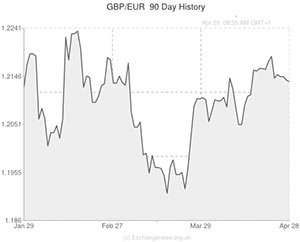
Ahead of the release of influential UK growth figures, the Pound was modestly stronger against the Euro and trading close to a four-year high against the US Dollar.
Sterling has been buoyed ever since impressive UK employment figures were published earlier this month, and additional signs of the UK’s economic strength have helped the currency largely retain gains.
Over the course of European trading the Pound was holding its own against the majority of its most traded currency counterparts due to the expectation that tomorrow’s UK GDP report will show that the nation’s economy expanded by 0.9 per cent in the first quarter of 2014.
This would follow growth of 0.7 per cent in the final quarter of 2013 and be the most impressive quarterly expansion recorded for four years.
Furthermore, the odds of the Bank of England raising interest rates from record lows may increase following a strong GDP figure.
According to Bloomberg News, currency strategist Stuart Bennett commented; ‘GDP figures are out tomorrow and with good news people have decided to test recent highs. The market is still quite long Sterling, it’s a crowded trade at the moment and it’s going to take a lot to jump higher’.
Other factors lending the Pound support today include a Hometrack report showing a 0.6 per cent increase in UK house prices. All ten of the regions monitored by Hometrack recorded price gains, and the monthly advance was the 15th consecutive jump.
In a statement issued with the figures, Hometrack researcher Richard Donnell observed that the ‘pickup in the coverage of price rises is very clear-cut’ with ‘improving market sentiment and low mortgage rates […] supporting increased activity.’
Meanwhile, the Confederation of British Industry’s growth expectations indicator rallied to its highest level since records began and the Lloyds Business Barometer jumped from 44 to 66 in April.
The Pound’s advance against the US Dollar was also enabled by the fact that the ‘Greenback’ came under pressure on Monday.
The safe-haven currency eased lower against several of its major rivals ahead of the Federal Open Market Committee meeting and the release of US growth and non-farm payrolls figures.
If the Fed adopts a dovish tone or if the US data fails to meet estimates the US Dollar could extend declines as the week continues.
However, if the US reports surprise to the upside, and add to the case for a Fed rate hike, the ‘Greenback’ could come out on top in the GBP to USD pairing.
Other UK reports to be aware of this week include the GfK consumer confidence survey and manufacturing/construction PMI.
Pound to Euro Update – 15.45, 29/04/14
On Tuesday the GBP to Euro pairing slipped modestly following the release of UK growth figures.
While the quarterly expansion of 0.8 per cent recorded in the first three months of the year marked a fifth quarter of UK expansion, and was an improvement on the growth of 0.7 per cent seen in the fourth quarter of 2013, the result disappointed some investors.
Economists had envisaged a GDP gain of 0.9 per cent while the Bank of England expected growth of 1 per cent.
The Pound briefly declined after the data was published.
However, the Pound to Euro exchange rate recovered losses once German inflation data was released.
German EU harmonised CPI, as recorded by the Federal Statistics Office, was up 1.1 per cent last month. A CPI gain of 1.3 per cent had been forecast.
As Germany is the Eurozone’s largest economy, tomorrow’s inflation data for the 18-nation currency bloc may also fall short of estimates.
If that proves to be the case it will add to the pressure already piled on the European Central Bank, and the financial institution may have no choice but to bring in extra easing at its next meeting.
While tomorrow’s German CPI figure will be the main cause of volatility in the GBP/EUR pairing, German employment data will also be of interest.
The German economy is expected to have lost 10,000 positions in April with the unemployment rate holding at 6.7 per cent.
Pound (GBP) Exchange Rates
[table width=”100%” colwidth=”50|50|50|50|50″ colalign=”left|left|left|left|left”]
Currency, ,Currency,Rate ,
Pound Sterling, ,US Dollar,1.6830,
,US Dollar,1.6830,
Pound Sterling, ,Euro,1.2179,
,Euro,1.2179,
Pound Sterling, ,Australian Dollar,1.8157,
,Australian Dollar,1.8157,
Pound Sterling, ,New Zealand Dollar,1.9683,
,New Zealand Dollar,1.9683,
US Dollar, ,Pound Sterling,0.5942,
,Pound Sterling,0.5942,
Euro, ,Pound Sterling,0.8211,
,Pound Sterling,0.8211,
Australian Dollar, ,Pound Sterling,0.5505,
,Pound Sterling,0.5505,
New Zealand Dollar, ,Pound Sterling,0.5071,
,Pound Sterling,0.5071,
[/table]

Comments are closed.